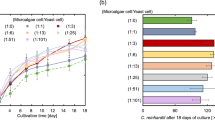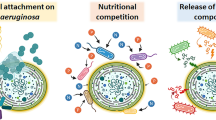Abstract
This study compared the efficiency of nutrient removal and lipid accumulation by a monoculture of Scenedesmus obliquus and mixed cultures of microalgae. The highest removal efficiencies of ammonium (99.2%), phosphate (91.2%), and total organic carbon (83.6%) occurred in the monoculture. All the mixed cultures were dominated by S. quadricauda; in some mixed cultures, the proportions of Chlamydomonas reinhardtii and C. microsphaera reached > 20%. The lipid content and lipid production in the monoculture were 15.9% and 52.3 mg kg−1, respectively, significantly higher than those in all the mixed cultures of microalgae. In all the mixed cultures, the proportion of palmitic acid was > 50%. The results suggest that the monoculture had advantages over the mixed culture of microalgae in terms of nutrient removal and lipid production.




Similar content being viewed by others
References
Álvarez-Díaz PD, Ruiz J, Arbib Z, Barragán J, Garrido-Pérez MC, Perales JA (2017) Freshwater microalgae selection for simultaneous wastewater nutrient removal and lipid production. Algal Res 24:477–485
Andruleviciute V, Makareviciene V, Skorupskaite V, Gumbyte M (2014) Biomass and oil content of Chlorella sp., Haematococcus sp., Nannochloris sp. and Scenedesmus sp. under mixotrophic growth conditions in the presence of technical glycerol. J Appl Phycol 26:83–90
Aravantinou AF, Theodorakopoulos MA, Manariotis ID (2013) Selection of microalgae for wastewater treatment and potential lipids production. Bioresour Technol 147:130–134
Bohutskyi P, Kligerman DC, Byers N, Nasr LK, Cua C, Chow S, Su C, Tang Y, Betenbaugh MJ, Bouwer EJ (2016) Effects of inoculum size, light intensity, and dose of anaerobic digestion centrate on growth and productivity of Chlorella, and Scenedesmus, microalgae and their poly-culture in primary and secondary wastewater. Algal Res 19:278–290
Breuer G, Lamers PP, Martens DE, Draaisma RB, Wijffels RH (2012) The impact of nitrogen starvation on the dynamics of triacylglycerol accumulation in nine microalgae strains. Bioresour Technol 124:217–226
Cai T, Park SY, Li Y (2013) Nutrient recovery from wastewater streams by microalgae: status and prospects. Renew Sust Energ Rev 19:360–369
Cea-Barcia G, Buitrón G, Moreno G, Kumar G (2014) A cost-effective strategy for the bio-prospecting of mixed microalgae with high carbohydrate content: diversity fluctuations in different growth media. Bioresour Technol 163:370–373
Cheirsilp B, Suwannarat W, Niyomdecha R (2011) Mixed culture of oleaginous yeast Rhodotorula glutinis and microalga Chlorella vulgaris for lipid production from industrial wastes and its use as biodiesel feedstock. New Biotechnol 28:362–368
Chinnasamy S, Bhatnagar A, Hunt RW, Das KC (2010) Microalgae cultivation in a wastewater dominated by carpet mill effluents for biofuel applications. Bioresour Technol 101:3097–3105
Chiu SY, Kao CY, Chen TY, Chang YB, Kuo CM, Lin CS (2015) Cultivation of microalgal Chlorella for biomass and lipid production using wastewater as nutrient resource. Bioresour Technol 184:179–189
Delgadillo-Mirquez L, Lopes F, Taidi B, Pareau D (2016) Nitrogen and phosphate removal from wastewater with a mixed microalgae and bacteria culture. Biotechnol Rep 11:18–26
Devi MP, Subhash GV, Mohan SV (2012) Heterotrophic cultivation of mixed microalgae for lipid accumulation and wastewater treatment during sequential growth and starvation phases: effect of nutrient supplementation. Renew Energy 43:276–283
Federation WE, American Public Health Association (2005) Standard methods for the examination of water and wastewater. American Public Health Association (APHA), Washington, DC
Gan X, Shen G, Xin B, Li M (2016) Simultaneous biological desalination and lipid production by Scenedesmus obliquus cultured with brackish water. Desalination 400:1–6
Han L, Pei H, Hu W, Jiang L, Ma G, Zhang S, Han F (2015) Integrated campus sewage treatment and biomass production by Scenedesmus quadricauda SDEC-13. Bioresour Technol 175:262–268
Ho SH, Chen CY, Chang JS (2012) Effect of light intensity and nitrogen starvation on CO2 fixation and lipid/carbohydrate production of an indigenous microalga Scenedesmus obliquus CNW-N. Bioresour Technol 113:244–252
Hodaifa G, Martínez ME, Sánchez S (2008) Use of industrial wastewater from olive-oil extraction for biomass production of Scenedesmus obliquus. Bioresour Technol 99:1111–1117
Hu H (ed) (2006) The freshwater algae of China: systematics, taxonomy and ecology. Science Press
Knothe G (2005) Dependence of biodiesel fuel properties on the structure of fatty acid alkyl esters. Fuel Process Technol 86:1059–1070
Kuo CM, Chen TY, Lin TH, Kao CY, Lai JT, Chang JS, Lin CS (2015) Cultivation of Chlorella sp. GD using piggery wastewater for biomass and lipid production. Bioresour Technol 194:326–333
Lee KY, Ng TW, Li G, An T, Kwan KK, Chan KM, Huang G, Yip HY, Wong PK (2015) Simultaneous nutrient removal, optimised CO2 mitigation and biofuel feedstock production by Chlorogonium sp. grown in secondary treated non-sterile saline sewage effluent. J Hazard Mater 297:241-250
Li M, Zhu W, Dai X, Li X (2013) Effects of linear alkylbenzene sulfonate on extracellular polysaccharide content and cells per particle of Microcystis aeruginosa and Scenedesmus obliquus. Fresenius Environ Bull 22:1189–1194
Long BM, Jones GJ, Orr PT (2001) Cellular microcystin content in N-limited Microcystis aeruginosa can be predicted from growth rate. Appl Environ Microbiol 67:278–283
Mahapatra DM, Chanakya HN, Ramachandra TV (2014) Bioremediation and lipid synthesis through mixotrophic algal consortia in municipal wastewater. Bioresour Technol 168:142–150
Marjakangas JM, Chen CY, Lakaniemi AM, Puhakka JA, Whang LM, Chang JS (2015) Selecting an indigenous microalgal strain for lipid production in anaerobically treated piggery wastewater. Bioresour Technol 191:369–376
Mata TM, Martins AA, Caetano NS (2010) Microalgae for biodiesel production and other applications: a review. Renew Sust Energ Rev 14:217–232
Mohan SV, Devi MP, Mohanakrishna G, Amarnath N, Babu ML, Sarma PN (2011) Potential of mixed microalgae to harness biodiesel from ecological water-bodies with simultaneous treatment. Bioresour Technol 102:1109–1117
Ogbonna JC, Yoshizawa H, Tanaka H (2000) Treatment of high strength organic wastewater by a mixed culture of photosynthetic microorganisms. J Appl Phycol 12:277–284
Osundeko O, Pittman JK (2014) Implications of sludge liquor addition for wastewater-based open pond cultivation of microalgae for biofuel generation and pollutant remediation. Bioresour Technol 152:355–363
Park J, Jin HF, Lim BR, Park KY, Lee K (2010) Ammonia removal from anaerobic digestion effluent of livestock waste using green alga Scenedesmus sp. Bioresour Technol 101(22):8649–8657
Peng Q, Zhao M, Shen G, Gan X, Li M (2017) Linear alkylbenzene sulfonate (LAS) promotes sedimentation and lipid accumulation in Scenedesmus obliquus. RSC Adv 7:9244–9250
Ruiz-Martinez A, Serralta J, Pachés M, Seco A, Ferrer J (2014) Mixed microalgae culture for ammonium removal in the absence of phosphorus: effect of phosphorus supplementation and process modeling. Process Biochem 49:2249–2257
Sabu S, Singh ISB, Joseph V (2017) Optimisation of critical medium components and culture conditions for enhanced biomass and lipid production in the oleaginous diatom Navicula phyllepta: a statistical approach. Environ Sci Pollut Res 24:26763–26777
Salama ES, Kim HC, Abou-Shanab RA, Ji MK, Oh YK, Kim SH, Jeon BH (2013) Biomass, lipid content, and fatty acid composition of freshwater Chlamydomonas mexicana and Scenedesmus obliquus grown under salt stress. Bioprocess Biosyst Eng 36(6):827–833
Shen QH, Jiang JW, Chen LP, Cheng LH, Xu XH, Chen HL (2015) Effect of carbon source on biomass growth and nutrients removal of Scenedesmus obliquus for wastewater advanced treatment and lipid production. Bioresour Technol 190:257–263
Shen Y, Gao J, Li L (2017a) Municipal wastewater treatment via co-immobilized microalgal-bacterial symbiosis: microorganism growth and nutrients removal. Bioresour Technol 243:905–913
Shen G, Qu D, Li K, Li M (2017b) Composition of extracellular and intracellular polymeric substances produced by Scenedesmus and Microcystis. Environ Eng Sci 34(12):887–894
Sorokin C, Krauss RW (1958) The effects of light intensity on the growth rates of green algae. Plant Physiol 33:109–113
Stockenreiter M, Haupt F, Seppälä J, Tamminen T, Spilling K (2016) Nutrient uptake and lipid yield in diverse microalgal communities grown in wastewater. Algal Res 15:77–82
Sutherland DL, Turnbull MH, Broady PA, Craggs RJ (2014) Wastewater microalgal production, nutrient removal and physiological adaptation in response to changes in mixing frequency. Water Res 61:130–140
Tarlan E, Dilek FB, Yetis U (2002) Effectiveness of algae in the treatment of a wood-based pulp and paper industry wastewater. Bioresour Technol 84:1–5
Travieso L, Benítez F, Sánchez E, Borja R, Martín A, Colmenarejo MF (2006) Batch mixed culture of Chlorella vulgaris using settled and diluted piggery waste. Ecol Eng 28:158–165
Voltolina D, Cordero B, Nieves M, Soto LP (1999) Growth of Scenedesmus sp. in artificial wastewater. Bioresour Technol 68(3):265–268
Wahlen BD, Willis RM, Seefeldt LC (2011) Biodiesel production by simultaneous extraction and conversion of total lipids from microalgae, cyanobacteria, and wild mixed-cultures. Bioresour Technol 102:2724–2730
Wang Y, Jiang Y, Ping W, Deng S, Chang J, Ran Z (2017) Response of energy microalgae Chlamydomonas reinhardtii to nitrogen and phosphorus stress. Environ Sci Pollut Res 25:5762–5770
WHO (2011) Guidelines for drinking-water quality. World Health Organization
Wrede D, Taha M, Miranda AF, Kadali K, Stevenson T, Ball AS, Mouradov A (2014) Co-cultivation of fungal and microalgal cells as an efficient system for harvesting microalgal cells, lipid production and wastewater treatment. PLoS One 9:e113497
Wu YH, Hu HY, Yu Y, Zhang TY, Zhu SF, Zhuang LL, Zhang X, Lu Y (2014) Microalgal species for sustainable biomass/lipid production using wastewater as resource: a review. Renew Sust Energ Rev 33:675–688
Zhao Y, Ge Z, Lui H, Sun S (2016) Ability of different microalgae species in synthetic high-strength wastewater treatment and potential lipid production. J Chem Technol Biotechnol 91:2888–2895
Zhu W, Chen H, Guo L, Li M (2016) Effects of linear alkylbenzene sulfonate (LAS) on the interspecific competition between Microcystis and Scenedesmus. Environ Sci Pollut Res 23:16194–16200
Acknowledgements
Dr. Ming Li is funded as a Tang Scholar by the Cyrus Tang Foundation and Northwest A&F University. We thank Catherine Dandie, PhD, from Liwen Bianji, Edanz Editing China (www.liwenbianji.cn/ac), for editing the English text of a draft of this manuscript.
Funding
This work was supported by the CRSRI Open Research Program (CKWV2017532/KY), the Scientific Research and Service Platform fund of Henan Province (2016151), the Scientific and Technological Innovation Team of Water Ecological Security for Water Source Region of Mid-line of South-to-North Diversion Project of Henan Province (17454), and the State-level Public Welfare Scientific Research Institutes Basic Scientific Research Business Project of China (CKSF2017062/SH).
Author information
Authors and Affiliations
Corresponding author
Additional information
Responsible editor: Ta Yeong Wu
Publisher’s note
Springer Nature remains neutral with regard to jurisdictional claims in published maps and institutional affiliations.
Electronic supplementary material
ESM 1
(DOCX 43 kb)
Rights and permissions
About this article
Cite this article
Qu, Z., Duan, P., Cao, X. et al. Comparison of monoculture and mixed culture (Scenedesmus obliquus and wild algae) for C, N, and P removal and lipid production. Environ Sci Pollut Res 26, 20961–20968 (2019). https://doi.org/10.1007/s11356-019-05339-z
Received:
Accepted:
Published:
Issue Date:
DOI: https://doi.org/10.1007/s11356-019-05339-z




